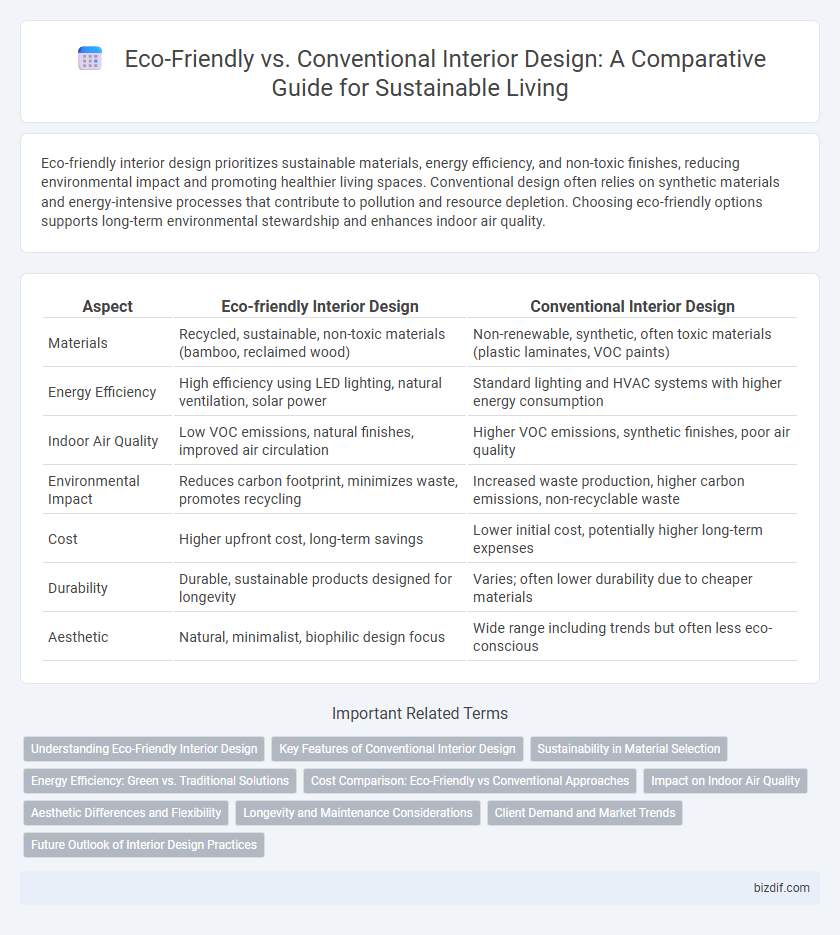Eco-friendly interior design prioritizes sustainable materials, energy efficiency, and non-toxic finishes, reducing environmental impact and promoting healthier living spaces. Conventional design often relies on synthetic materials and energy-intensive processes that contribute to pollution and resource depletion. Choosing eco-friendly options supports long-term environmental stewardship and enhances indoor air quality.
Table of Comparison
| Aspect | Eco-friendly Interior Design | Conventional Interior Design |
|---|---|---|
| Materials | Recycled, sustainable, non-toxic materials (bamboo, reclaimed wood) | Non-renewable, synthetic, often toxic materials (plastic laminates, VOC paints) |
| Energy Efficiency | High efficiency using LED lighting, natural ventilation, solar power | Standard lighting and HVAC systems with higher energy consumption |
| Indoor Air Quality | Low VOC emissions, natural finishes, improved air circulation | Higher VOC emissions, synthetic finishes, poor air quality |
| Environmental Impact | Reduces carbon footprint, minimizes waste, promotes recycling | Increased waste production, higher carbon emissions, non-recyclable waste |
| Cost | Higher upfront cost, long-term savings | Lower initial cost, potentially higher long-term expenses |
| Durability | Durable, sustainable products designed for longevity | Varies; often lower durability due to cheaper materials |
| Aesthetic | Natural, minimalist, biophilic design focus | Wide range including trends but often less eco-conscious |
Understanding Eco-Friendly Interior Design
Eco-friendly interior design prioritizes sustainable materials such as bamboo, reclaimed wood, and low-VOC paints to reduce environmental impact and improve indoor air quality. Unlike conventional designs that often rely on synthetic, non-recyclable products, eco-friendly practices emphasize energy efficiency, natural light optimization, and waste reduction. This approach not only enhances aesthetic appeal but also promotes healthier living spaces and long-term ecological balance.
Key Features of Conventional Interior Design
Conventional interior design emphasizes traditional materials such as hardwood, carpet, and synthetic fibers, which often have higher environmental footprints. The use of non-renewable resources and chemical-based finishes characterizes its approach, prioritizing durability and aesthetic familiarity over sustainability. This design style typically involves standard manufacturing processes that contribute to greater waste and energy consumption compared to eco-friendly alternatives.
Sustainability in Material Selection
Sustainable material selection in interior design prioritizes eco-friendly options such as reclaimed wood, bamboo, and recycled metals that reduce environmental impact and promote resource conservation. Unlike conventional materials, which often involve high energy consumption and toxic chemicals, sustainable alternatives enhance indoor air quality and support circular economy principles. Choosing eco-friendly materials contributes to long-term durability, reduced carbon footprint, and a healthier living environment.
Energy Efficiency: Green vs. Traditional Solutions
Eco-friendly interior design prioritizes energy efficiency by incorporating sustainable materials like bamboo and cork, along with LED lighting and smart thermostats to reduce energy consumption. Traditional solutions often rely on less efficient lighting and insulation materials, resulting in higher utility costs and environmental impact. Integrating green technologies enhances both comfort and cost savings while minimizing the carbon footprint of living spaces.
Cost Comparison: Eco-Friendly vs Conventional Approaches
Eco-friendly interior design materials often involve higher upfront costs due to sustainable sourcing and production methods, but they offer long-term savings through energy efficiency and durability. Conventional materials typically have lower initial expenses but may lead to increased maintenance and replacement costs over time. Investing in eco-friendly options balances environmental benefits with economic advantages by reducing utility bills and minimizing waste-related expenses.
Impact on Indoor Air Quality
Eco-friendly interior design significantly improves indoor air quality by utilizing non-toxic, natural materials such as low-VOC paints, bamboo flooring, and organic textiles that reduce harmful chemical emissions. Conventional designs often rely on synthetic materials and finishes that emit volatile organic compounds (VOCs), contributing to poor air quality and respiratory issues. Studies show homes with eco-friendly interiors can have up to 50% lower levels of indoor pollutants, promoting healthier living environments.
Aesthetic Differences and Flexibility
Eco-friendly interior design prioritizes natural materials and sustainable elements, resulting in spaces with organic textures, earthy tones, and a softer aesthetic that complements environmental consciousness. Conventional design often utilizes synthetic materials and polished finishes, offering a wider range of vibrant colors and glossy surfaces for a more varied visual impact. Eco-friendly designs typically allow greater flexibility by incorporating modular components and biodegradable options that adapt easily to evolving styles and reduce environmental impact.
Longevity and Maintenance Considerations
Eco-friendly interior design materials like bamboo and reclaimed wood offer excellent durability and minimal maintenance due to their natural resistance to wear and environmental stress. Conventional materials such as pressed wood and synthetic laminates may require frequent repairs and replacements, increasing long-term costs and environmental impact. Selecting sustainable options supports both the longevity of design elements and reduces maintenance efforts by leveraging resilient, non-toxic materials.
Client Demand and Market Trends
Rising client demand for sustainable living fuels the growth of eco-friendly interior design, emphasizing natural materials, energy-efficient lighting, and low-VOC paints. Market trends reveal a significant shift towards green certification and environmentally responsible sourcing as clients increasingly prioritize health and environmental impact. Conventional design methods face declining popularity due to heightened awareness of carbon footprint and resource conservation in modern interior projects.
Future Outlook of Interior Design Practices
Eco-friendly interior design is projected to dominate future practices due to increasing consumer demand for sustainable living and stricter environmental regulations. Innovations in materials such as recycled composites, low-VOC paints, and energy-efficient lighting systems will reduce the carbon footprint of interior spaces. Conventional design methods are likely to evolve by integrating green technologies and sustainable principles to balance aesthetics with ecological responsibility.
Eco-friendly vs Conventional Infographic

 bizdif.com
bizdif.com